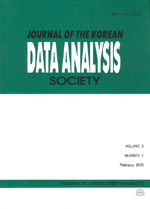시스템 일반화 적률법을 이용한 자본구조 조정 속도의 추정
The Estimation of Capital Structure Adjustment Speeds using System GMM
- 한국자료분석학회
- Journal of The Korean Data Analysis Society (JKDAS)
- Vol.17 No.2
-
2015.04811 - 821 (11 pages)
- 85

본 연구는 기업이 목표 자본구조와 현재 자본구조와의 거리를 좁히려 한다는 가정 하에서, 이론이 제시하는 동적 모형을 이용하여 자본구조의 조정 속도를 추정한다. 동적 패널 모형의 경우 종속 변수의 이전 기의 값이 설명변수에 포함되는데 이는 오차항과 상관관계를 가지고 있다. 이를 고려하지 않는 추정법을 이용하면, 계수값에 Nickell(1981)이 제시한 하향 편의가 발생하게 된다. 이를 통제하기 위해 본 연구에서는 Blundell, Bond(1998)가 제시한 2단계 시스템 일반화 적률법을 이용하여 조정 속도를 추정하며 그 결과를 고정효과만을 고려하여 추정한 결과와 비교하였다. 검증 결과, 우선 개별 기업의 부채비율에는 시계열적으로 평균회귀 성향을 가지고 있음이 검증되었다. 이에 근거하여 추정된 자본구조 조정 모형의 추정결과에 따르면, 두 추정 방법을 사용한 경우 모두 표본 기업들은 목표 부채비율을 향해 현 부채비율과의 괴리의 일부를 유의적으로 조정하고 있는 것으로 검증되었다. 이는 상충이론을 뒷받침하는 결과이다. 그러나 고정효과분석을 사용한 경우에는 이전 기 부채비율의 계수값이 시스템 일반화 적률법을 사용한 경우에 비해 낮게 추정되어 조정 속도의 과대평가를 유인하는 것으로 확인되었다. 이는 동적 특성이 있는 패널 자료를 다루는 경우 이를 고려한 통계적 방법의 선택이 중요함을 나타내는 결과로서 Baltagi (2008)의 주장과 일관된 것이다.
This paper estimates the capital structure adjustment speeds toward target debt ratio. The relatedness between lagged dependent variable and the error term in the dynamic adjustment model of capital structure causes a statistical estimation problem known as Nickell s (1981) bias. To identify this problem, we compare the adjustment speed estimated using Blundell, Bond (1998) 2-step system GMM with that estimated using fixed effects regression. We find that firms with high debt ratio are likely to decrease it. The result suggests that debt ratio has a mean-reverting pattern and justifies the partial adjustment model of capital structure which includes the lagged dependent variable as one of explanatory variables. The result from either estimation method shows that firms partially adjust their debt ratio toward target capital structure. However, the coefficient of lagged debt ratio obtained using fixed effects regression is shown to be biased downward and leads to overestimate the partial adjustment speed. It suggests that a choice of econometric method is important in dealing with dynamic panel data, consistent with Baltagi (2008)
1. 서론
2. 기존 연구
3. 자본구조 조정 모형과 추정 방법
4. 실증분석 결과
5. 결론
References
(0)
(0)